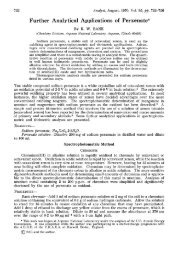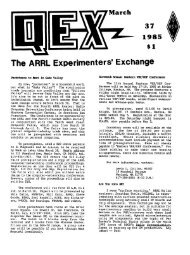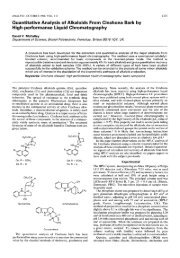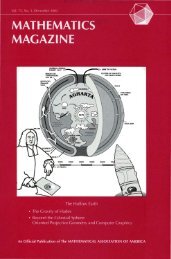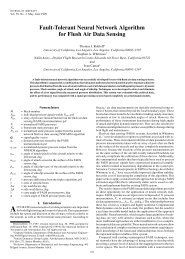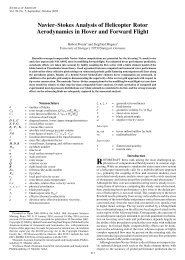pdf 6436KB Sep 25 2010 04
pdf 6436KB Sep 25 2010 04
pdf 6436KB Sep 25 2010 04
- TAGS
- 81.70.242.211
Create successful ePaper yourself
Turn your PDF publications into a flip-book with our unique Google optimized e-Paper software.
un on 40. The next minute everything<br />
sounds like ‘Mary Had a Little Lamb’<br />
played on the ocarina.”<br />
“Propagation was not too bad. Basically,<br />
20 was open the entire 24 hours to somewhere.<br />
At 0800 we were working the East<br />
Coast on long path and listening to our<br />
echoed signals traveling around the globe<br />
— which seems really cool when you are<br />
sleep deprived. There was a brief opening<br />
on 15 and an even shorter one on 10.<br />
“We lost our 160 meter antenna right<br />
before the start of the contest when someone<br />
let the smoke out of the antenna relay<br />
switch. I don’t think it cost us too much. We<br />
did fi ne on 40, but we really had a hard<br />
time on 80 with the compromise vertical<br />
we were running. That is something we<br />
need to work on for next time.”<br />
John reported that working Europe “was<br />
a stretch” that weekend. “We got some,<br />
but they were hard work.” Fortunately, the<br />
team found favorable propagation to Oceania<br />
and to the Far East and was able to log<br />
a respectable number of fi ve-pointers.<br />
Using a 1×1 call sign carries its own<br />
benefits and challenges, he said, but<br />
it puts all stations on an equal footing<br />
with respect to call sign length. “But the<br />
most comical moment of the contest was<br />
listening to Dan trying to explain a 1×1<br />
call to D4C, who should have been able<br />
to fi gure it out: ‘One, two, three. You have<br />
three, we have three.’ I wish I’d had a tape<br />
recorder.”<br />
“We had two stations networked with<br />
WriteLog, and that was pretty sweet,” he<br />
recounted. “You can set it up so that when<br />
one station is sending, it locks out the<br />
other. There were some limitations and<br />
a couple of minor problems, but it was a<br />
solid confi guration that I<br />
wouldn’t hesitate to use<br />
again.”<br />
“All in all, it was fun and<br />
educational,” John said in<br />
summary. He quipped that<br />
Amateur Radio contests<br />
should not be sponsored<br />
by radio manufacturers<br />
but by purveyors of coffee,<br />
caffeinated soft drinks,<br />
beef jerky and pretzels.<br />
“Wearing Depends does<br />
not improve your score,”<br />
he added.<br />
“We are already making<br />
plans and coming up with<br />
ideas for next year. Thanks<br />
to K6AM and the SCCC for<br />
this great idea!”<br />
W6C<br />
Paul, WN6K, and Juan,<br />
W6NOW, operated as<br />
W6C. “As there were only<br />
three 1×1 stations on the<br />
air for the WCRRTC event<br />
42 November/December 2008 NCJ<br />
W6B Scoring Summary<br />
Band SSB QSOs CW QSOs Total QSOs Mults<br />
160 0 0 0 0<br />
80 7 11 18 6<br />
40 131 74 205 26<br />
20 267 365 632 55<br />
15 71 19 90 15<br />
10 7 4 11 3<br />
Total 484 473 956 105<br />
W6C Scoring Summary<br />
Band CW QSOs SSB QSOs Zones HQ Stns<br />
160 0 0 0 0<br />
80 124 2 9 4<br />
40 323 12 21 5<br />
20 200 115 14 6<br />
15 24 41 9 0<br />
10 0 0 0 0<br />
Total 667 170 53 15<br />
created by John, K6AM, someone had to<br />
come in last,” Paul philosophized afterward.<br />
“Band conditions were sporadic.<br />
Although at times we heard loud stations<br />
calling CQ, we just could not be heard<br />
by them, and they were those precious<br />
multipliers.<br />
“Juan and I only used a single radio due<br />
to no equipment here at WN6K to operate<br />
SO2R,” Paul continued. “Although the rules<br />
for our contest-inside-the-contest allowed<br />
that we could switch bands with impunity,<br />
we chose to stay within the 10-minute<br />
rule of the IARU so that we could submit<br />
a ‘regular’ score there.”<br />
According to Paul, he handled all of the<br />
CW operating while Juan dealt with “the<br />
other mode,” with the exception of 40 and<br />
75 meters, where they took turns. He said<br />
the pair had more requests to repeat their<br />
1×1 call sign on SSB than on CW.<br />
“Thanks for the QSOs. We got a minitaste<br />
of what the WRTC might feel like,”<br />
he concluded. “Bottom line: Lots of fun,<br />
but competing at WRTC level is in the F 2<br />
layer as far as our abilities and equipment<br />
limitations go. Do more S&P if you are not<br />
loud is the lesson learned, but then that’s<br />
why we contest — to learn more.”<br />
WCRRTC 2009?<br />
Thanks to all who helped by giving points<br />
to our teams. If there’s enough interest, we<br />
will try it again next year.



